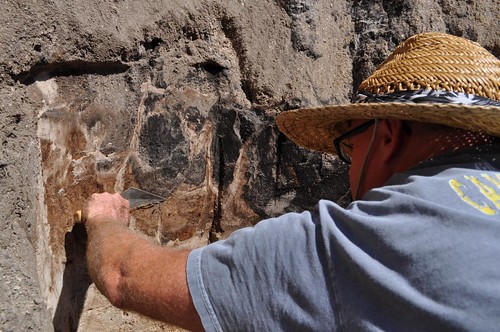Archaeologists uncover 13,000-year-old bones of ancient, extinct species of bison

Archaeologists uncover 13,000-year-old bones of ancient, extinct species of bison
Discovery made just 10 feet below the ground's surface at Old Vero Man site.
FLORIDA ATLANTIC UNIVERSITY—In what is considered one of the oldest and most important archaeological digs in North America, scientists have uncovered what they believe are the bones of a 13,000- to 14,000-year-old ancient, extinct species of bison at the Old Vero Man Site in Vero Beach, Fla. Archaeologists from Florida Atlantic University's Harbor Branch Oceanographic Institute made this discovery just 10 feet below the ground's surface during the final stretch of the 2016 excavation efforts at the Vero Beach site.
The bone was found below a layer that contained material from the Pleistocene period when the last ice age was thought to have occurred. The archaeologists identified the bison using an upper molar, which is thought to be representative of a Bison antiquus , a direct ancestor of the American bison that roamed North America until it became extinct. Because bison was a grassland-adapted animal, nearly 100 percent of their bones disintegrated after death unless they were preserved in some way.
"This finding is especially significant because of the meticulous documentation that has been involved," said James M. Adovasio, Ph.D., principal investigator. "Along with the fact that bones like this have never been found on land as part of a calculated archaeological effort. Others like this have all been found underwater, in sinkholes or streams."
______________________________________
In what is considered one of the oldest and most important archaeological digs in North America, scientists have uncovered what they believe are the bones of a 13,000- to 14,000-year-old ancient, extinct species of bison at the Old Vero Man Site in Vero Beach, Fla. Credit: Harbor Branch Oceanographic Institute, Florida Atlantic University
______________________________________________________
Bison antiquus , sometimes referred to as the "ancient bison," was the most common large herbivore of the North American continent for more than 10,000 years, and is a direct ancestor of the living American bison. They were approximately 8 feet tall, 15 feet long and weighed close to 3,500 pounds.
"We couldn't have asked for a better representative species from that era," said Andrew Hemmings, Ph.D., lead archaeologist. "We now know that people were here in Vero Beach at that time."
The bones of the ancient bison have been moved to FAU's Ancient DNA Lab at Harbor Branch for further research and examination. The lab was established in 2011 to investigate the population biology, genetic diversity and species composition of past ecosystems.
Scientists also found other bones at the site from small mammals, along with slivers of bones from large mammals that could have come from mammoth, mastodon, sloth or bison. Pieces of charcoal and the head of a fly were discovered earlier in this year's excavation, which began in late February.
The Old Man Vero Site was originally discovered in 1915 after construction efforts on a drainage canal exposed the well-preserved remains of late Pleistocene flora and fauna in association with human remains and artifacts.
Source: News release of the Florida Atlantic University .
_____________________________________________________
The archaeological dig was led by Harbor Branch and FAU's Department of Anthropology within the Dorothy F. Schmidt College of Arts and Letters, in partnership with the Old Vero Man Ice Age Sites Committee (OVIASC).- FAU -





Many amazing finds are coming out of the ''Old Vero Man'' site.
How very fascinating!!! What a find! I wonder which part they're scraping on, in the picture...
It sounds like it was huge! 3500 pounds!!! Wow!!!
Pretty amazing Dowser, when you consider that the Bison today top out at around 2,000 lbs.
Golly! I figured, wrongly, that they were about the size of a cow-- 1500-2000 pounds. This must have been HUGE!
I wish they were still around...
Phenomenal - got another story 'bout a sinkhole having artifacts 14,550 Years old, also in that area. See front page.
Just read the article and commented.
What amazing finds. To think that the early natives were here at the same time as these ancient bison.
What are they going to find next. A exciting time.
This thing was 8 feet tall! I've seen the modern ones in Wyoming and they're huge and definitely not docile. It took a lot of nerve for Indians to hunt a buffalo on horseback armed with a bow and arrow. There were no horses here 13,000 years ago so people would have to hunt this monster on foot. Even nervier.
I can't imagine even trying to hunt these monsters. still, with a lot of team work I can see how one can be brought down and, considering it's size, it would provide meat for a long time, to say nothing of the uses of the hide. Still, I'm sure many NA's died in these hunts.
They were probably armed with rocks and stone tipped stabbing spears 13,000 years ago. F**k that. Can you imagine being kicked, gored, or run over by something this big? Id rather be a vegetarian.
Vegetarian, Ojibwe for can't hunt.
Vegetarian, Ojibwe for can't hunt
That's me "can't hunt" . . . I'm going back to the cave to invent agriculture so you guys can one day have fries with that burger. And, while I'm doing that, I'm going to invent pornography by drawing on the cave wall what I've been doing all day.
Potato's were discovered and cultivated by the Natives of central and south American. You'll have to find something other than fries.
Potato chips were also discovered/invented by Natives.
In my historical fantasy, the natives of central and South America got potatoes from me. And all the children in the tribe looked like me too.
Potato chips were also discovered/invented by Natives.
We did invent the potato chip, but we did not invent the ''couch potato''. That's on you.
Whoever invented the couch, especially the pit group type with a chaise lounge part, should get some sort of Nobel Prize!
Another amazing find. Moving the time line further back, with every discovery. Could this species be related to the woodland bison of the upper plains? The Indians have stories(tales) about huge bison roaming the area. This is one to stay interested in. Thanks for the article, K.
The current woodland buffalo is around 10 percent larger then the more well known plains buffalo, dd.
I'm sure that they are all related and that these huge creatures roamed the woodland area of the north as well.
Ok, look people. Let's talk about how people of the past hunted. They didn't just run up to mammoths and throw rocks at them. Those people then were JUST AS SMART AS WE ARE, and highly motivated. They did what hunters do now, they used traps, nets, deadfalls and pits to SAFELY take down big game. Take desert kites for example, basically funnels that lead big game to a killing ground. Oh, another trick I forgot, box canyons, natural traps.
Tribes needed every healthy member and every member with skills. No one is going to risk one fingernail in a desperate hand to hand encounter with a 2 1/2 ton animal. They are going to watch how the animal behaves, learn to force it in the direction that favors the hunter, towards the edge of cliff, into a deep hole, whatever.
Your correct Wheel. The buffalo jump in Montana is one example of this.
They were highly skilled hunters and as you mentioned highly motivated, failure meant starvation, not going to the local supermarket for supplies.
Those people then were JUST AS SMART AS WE ARE, and highly motivated.
An argument could be made that we modern humans are actually dumber, than when we were hunter/gatherers.
True. We have invented processes that took away most of our hunter/gather skills. One is called the supermarket.